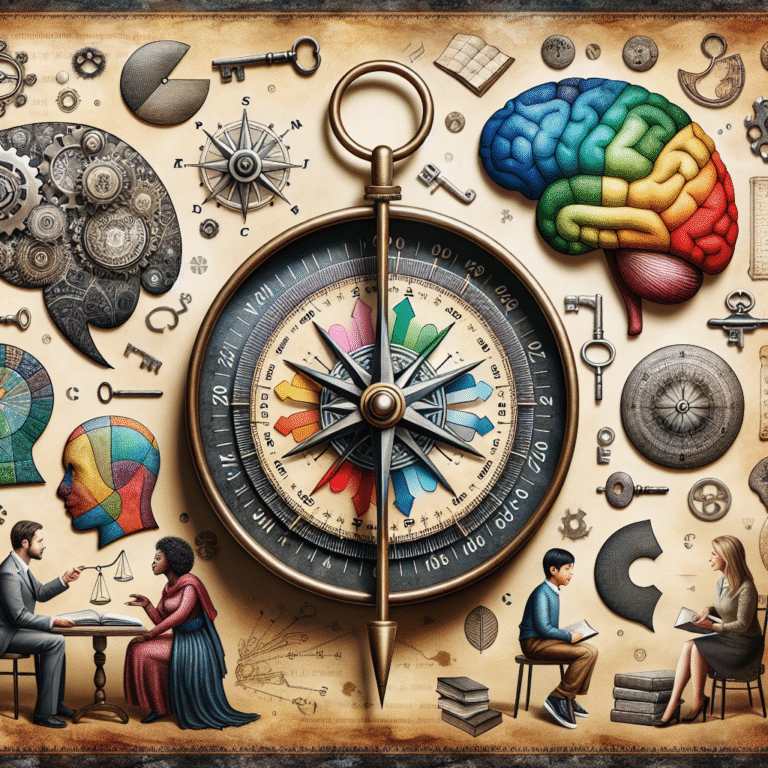
Introduction
Imagine a world filled with wonder through the eyes of a child, unsullied by preconceived notions and societal norms. Welcome to the realm of “Tiny Thinkers: How Infants Process the World Around Them.” This fascinating journey delves into the cognitive development of infants and how they interpret the vast array of stimuli that surround them. Understanding how these "tiny thinkers" process their environment not only illuminates their mental development but also enhances our approach to caregiving, education, and emotional support.
Infants are not empty vessels; they are active participants in their own learning processes. By exploring various aspects of infant cognition and perception, we can glean invaluable insights that can guide parents, educators, and caregivers alike.
The Foundation of Infant Cognition
Theories of Early Development
The field of child psychology has long pondered the intricacies of how infants make sense of their world. Renowned theorists such as Jean Piaget and Lev Vygotsky contributed significant frameworks that shed light on cognitive development.
Piaget’s Stages of Cognitive Development: Piaget posited that cognitive development occurs in stages, starting with the Sensorimotor Stage (birth to 2 years), where infants gain knowledge primarily through sensory experiences and motor actions.
- Vygotsky’s Social Development Theory: On the other hand, Vygotsky emphasized social interactions and cultural context as pivotal in shaping an infant’s cognitive development.
These theories provide a robust framework for understanding how tiny thinkers process the world around them.
Key Concepts in Infant Learning
Infants utilize a combination of sensory input, motor skills, and interaction with caregivers to understand their environment:
Sensory Exploration: Infants absorb information through their senses—sight, hearing, touch, taste, and smell.
Cause and Effect: As they explore, infants begin to understand fundamental cause-and-effect relationships. For example, they learn that shaking a rattle produces sound.
- Imitation: Infants are natural imitators. They learn behaviors not only by doing but by observing and mimicking those around them.
Case Study: The Baby Einstein Experiment
In a groundbreaking study by researchers at the University of California, a group of infants was observed during a series of interactions with parents using a set of learning toys designed to stimulate cognitive development. The results were illuminating:
After engaging with the toys, infants showed improved recognition of shapes and colors compared to those who interacted with less stimulating objects.
- This study highlights how active participation in learning accelerates cognitive development in tiny thinkers.
The Role of Emotions in Cognition
Attachment Theory
Attachment theory, developed by John Bowlby, offers insights into how infants’ emotional bonds with caregivers influence their cognitive processes. A securely attached infant is more inclined to explore their environment since they feel safe and supported.
The Impact of Emotional States
Infants’ emotional states can significantly impact their cognitive abilities. For instance:
Stress Responses: High levels of stress can hinder cognitive development, leading to difficulties in problem-solving and learning.
- Joyful Interactions: Positive interactions can enhance neural pathways associated with learning and memory.
Case Study: The Still Face Experiment
In this poignant experiment, researchers observed how a mother’s unresponsive behavior affected her infant’s emotional state and ability to engage. The results were eye-opening:
Infants displayed distress and confusion when faced with a "still face." This demonstrates that relational interactions are crucial for cognitive engagement.
- Understanding the emotional landscape of tiny thinkers is essential in fostering an environment conducive to learning and growth.
Sensory Development: A Gateway to Understanding
Vision and Hearing
How do tiny thinkers experience the world? The development of vision and hearing plays a critical role:
Visual Exploration: Infants are born with limited vision, but by 6 months, they can recognize faces and track movement, which sets the groundwork for social interaction.
- Auditory Learning: Infants are particularly responsive to their mother’s voice from birth, which can enhance early language acquisition.
Hands-On Learning: Tactile and Kinesthetic Experiences
Infants learn through touching and manipulating objects:
Textured Toys: Introducing various textures can stimulate cognitive development, aiding the differentiation of objects in their world.
- Movement: Crawling and eventually walking are vital stages that allow infants to explore further, enhancing their understanding of spatial relationships.
Chart: Growth Milestones in Sensory Development
| Age | Vision | Hearing | Touch |
|---|---|---|---|
| Newborn | Blurry, can see faces | Responds to sounds | Reacts to different textures |
| 3 Months | Follows moving objects | Localizes sound | Grabs and holds objects |
| 6 Months | Recognizes familiar faces | Prefers mother’s voice | Explores with hands and mouth |
| 12 Months | Depth perception develops | Understands simple words | Differentiates textures |
This chart exemplifies the progressive nature of sensory development and offers insights into the broad spectrum of how tiny thinkers process the world around them.
Language Development: The Building Blocks of Communication
The Beginnings of Language
Even before they utter their first words, infants are laying the groundwork for language.
Babbling: Babbling is a crucial phase in language development; it allows infants to practice vocalization, paving the way for speech.
- Gestures: Pointing and waving appear before actual words. These gestures signify cognitive understanding and facilitate communication between the infant and caregiver.
The Role of Caregivers
Caregivers play a pivotal role in language acquisition:
Modeling Language: Engaging in regular conversations with infants and narrating experiences can significantly bolster their language skills.
- Responsive Interaction: Encouraging infants to mimic sounds and respond to their babbling promotes language development.
Case Study: The Language Exposure Research
A study conducted by researchers from the University of Washington examined how differing levels of language exposure affected infants’ vocabulary development. Findings revealed:
Infants exposed to a rich verbal environment showed advanced language skills compared to those in less interactive environments.
- This reinforces the notion that the way tiny thinkers process language is intricately tied to their social interactions.
Understanding the World Through Play
The Importance of Free Play
Play is not merely a pastime; it is a fundamental aspect of cognitive development. Through play, infants practice skills that are crucial for problem-solving and exploratory learning.
Types of Play and Their Impact
Physical Play: Infants engage in movement-based play, such as crawling and climbing, which develops motor skills and spatial awareness.
- Symbolic Play: By pretending, infants start to understand symbolic relationships, critical for cognitive and language development.
Case Study: The Benefits of Free Play
A longitudinal study tracked a group of children from infancy through early childhood, observing their play patterns.
- Children who engaged in varied forms of play showed advanced problem-solving skills and creativity by the time they reached preschool.
This evidence reinforces the idea that through play, tiny thinkers are actively engaged in processing and understanding the world around them.
The Significance of Social Interactions
Learning Through Imitation
Infants learn a great deal from observing others. Imitation is an essential practice through which they acquire new skills, behaviors, and social norms.
Social Referencing
Infants often look to caregivers for cues on how to respond in new situations—this phenomenon is termed social referencing.
- Emotional Cues: If a caregiver reacts positively to a stranger, the infant is likely to approach; conversely, a negative reaction may cause the infant to retreat.
The Impact of Diverse Interactions
Engaging with various caregivers and peers enriches an infant’s cognitive processing. This diversity allows for a richer understanding of social dynamics and emotional complexity.
Case Study: The Neighborhood Play Study
A research project explored how interactions among infants in diverse socioeconomic backgrounds influenced their social skills. The findings indicated:
- Infants who engaged in play with peers from various backgrounds exhibited greater empathy and adaptability.
This supports the idea that through social experiences, tiny thinkers learn to navigate their environment effectively.
Conclusion
Understanding the nuanced ways in which tiny thinkers process the world around them enriches our appreciation of infant development. From sensory and emotional experiences to language acquisition and play, every element contributes to the cognitive tapestry being woven in these early years.
Motivational Takeaway
For parents and caregivers, nurturing a child’s cognitive development goes beyond providing basic needs; it encompasses engaging with them emotionally, socially, and intellectually. By recognizing the incredible processing capabilities of infants, we empower them to explore their world fearlessly.
FAQs
1. How do infants learn to communicate before speaking?
Infants communicate through gestures, facial expressions, and sounds. Babbling is a crucial step in laying the foundation for language development.
2. What role does play have in cognitive development?
Play stimulates problem-solving skills, creativity, and emotional understanding. Different types of play contribute to varied aspects of cognitive and social growth.
3. How can parents encourage language development in infants?
Engaging in regular conversations, reading together, and modeling language through everyday interactions can significantly enhance an infant’s language skills.
4. How does emotional attachment influence cognitive processing?
A secure emotional bond with caregivers fosters a sense of safety, encouraging infants to explore their environment and engage more deeply with learning experiences.
5. What are some common signs of cognitive development in infants?
Signs include improved motor skills, increased imitation of behaviors, stronger reactions to emotional cues, and growing curiosity about their surroundings.
In conclusion, the journey of exploring "Tiny Thinkers: How Infants Process the World Around Them" reveals an intricate web of cognitive, emotional, and social learning that shapes their understanding of life. Through support, engagement, and rich interactions, caregivers can nurture these developing minds, allowing them to thrive and flourish.

















